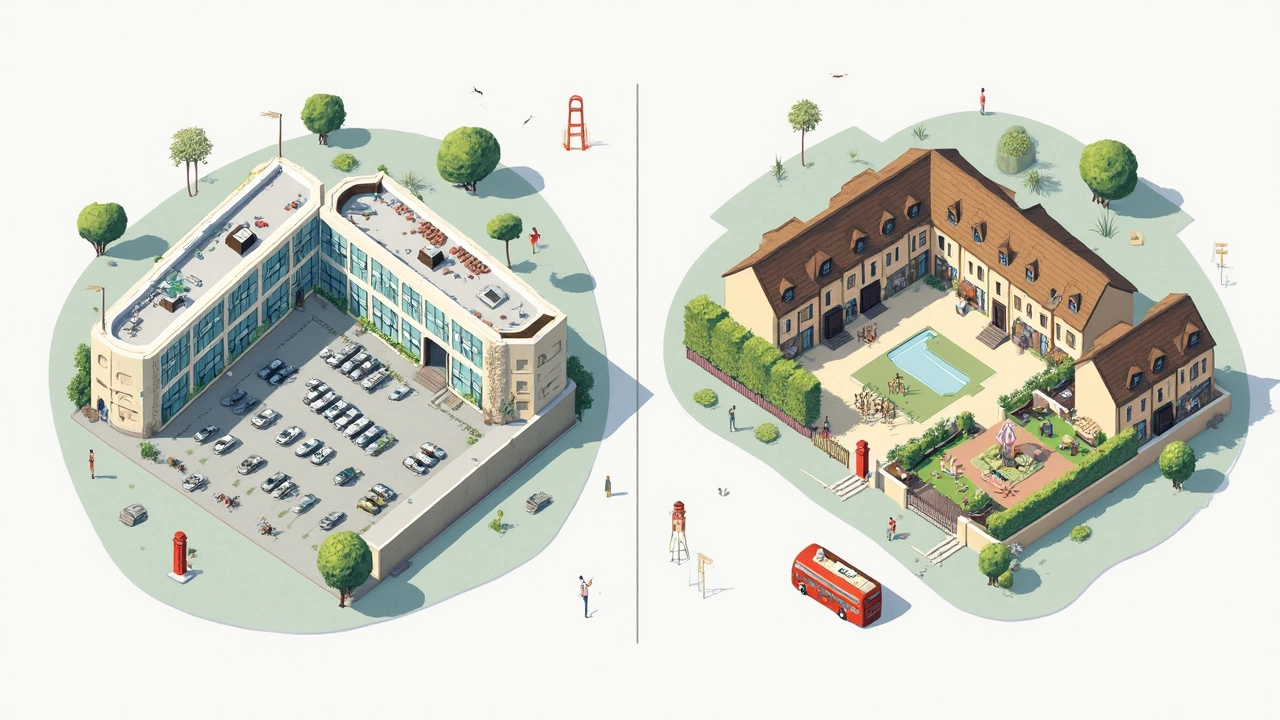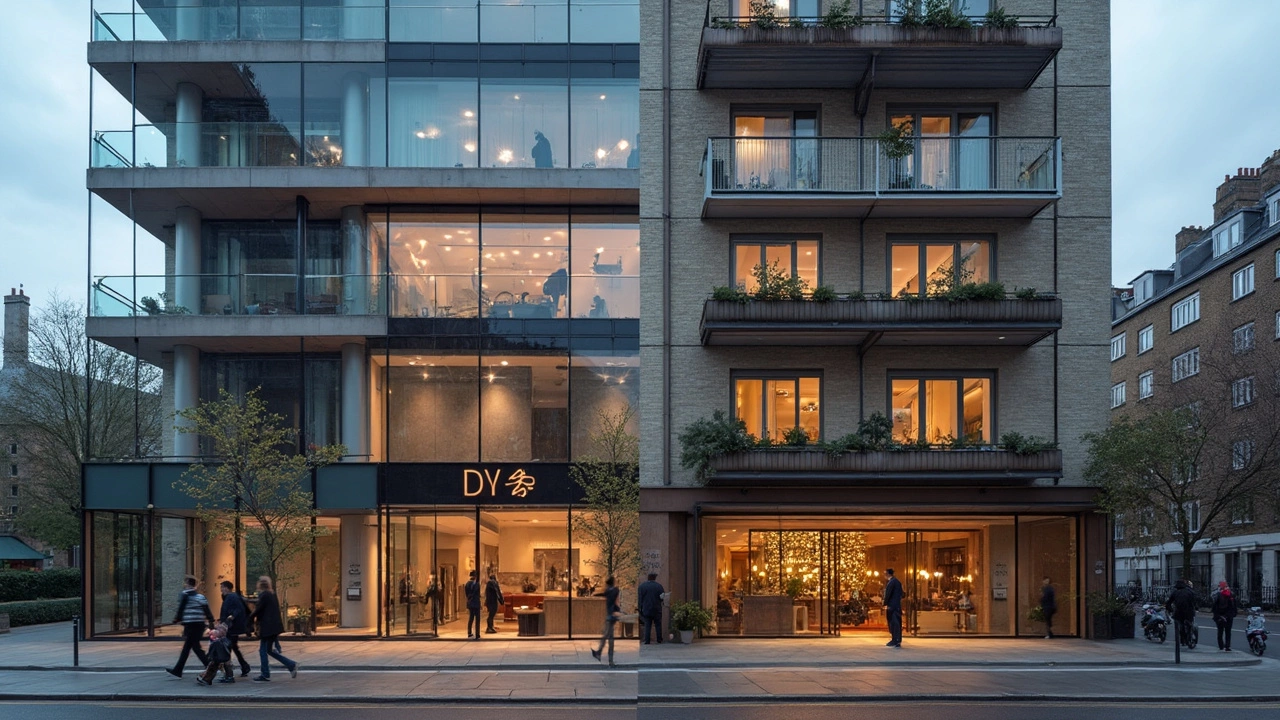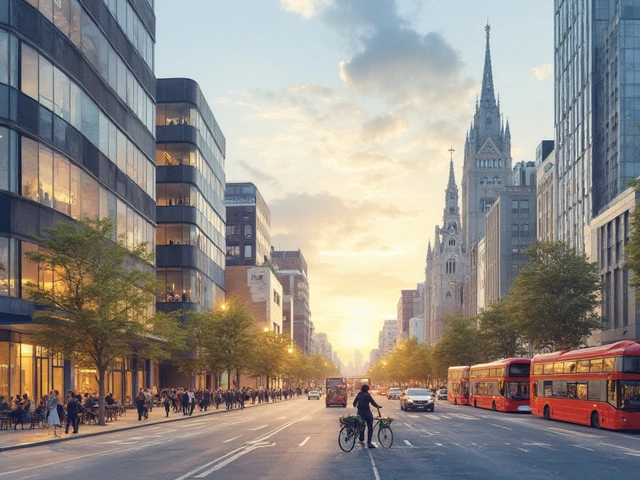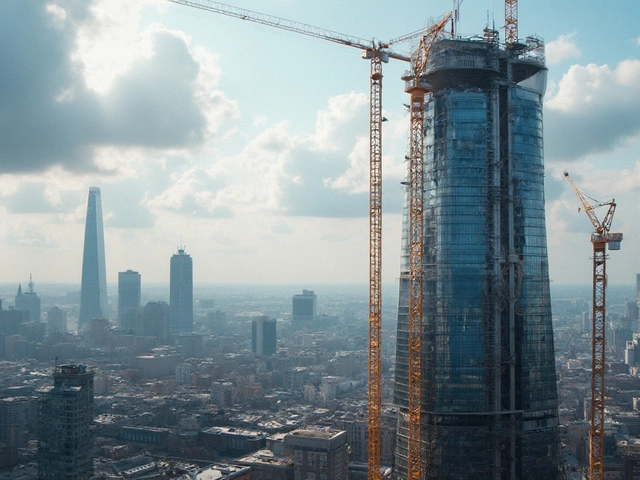Ever notice how office buildings feel worlds apart from the homes on your street? That’s not just about size or style—there are a ton of practical differences that matter if you’re thinking about construction, buying, or investing. The rules for what goes into a commercial property (like a warehouse, shop, or office tower) aren’t the same as for an apartment complex or neighborhood house.
Getting this straight can save you massive headaches. Building codes, safety features, even how you wire up the place—it all changes depending on whether you’re housing families or leasing out shop space. If you’ve ever wondered why a new strip mall takes longer to finish than a row of houses, or why the insurance costs are massively different, it all comes down to these differences.
Cut through the confusion before you put any serious money on the line. Spotting the right permits, knowing who inspects your site, and understanding what your tenants actually need can make or break a project. Let’s get crystal clear on how commercial and residential buildings really stack up.
- Purpose and Use
- Design and Construction Standards
- Legal and Safety Requirements
- Cost Factors and Financing
- Maintenance and Operations
- Tips for Choosing the Right Type
Purpose and Use
When you look at any building, its core purpose usually comes down to two main categories: either it's built for people to live in, or people to work, shop, or run a business. That's the line in the sand between commercial construction and residential buildings. Getting this sorted out is key, because the intended use controls almost every decision from layout to the final inspection.
Residential buildings are where people live: single-family homes, apartment buildings, condos, and duplexes. The focus is on comfort, privacy, and basic living amenities like kitchens, showers, bedrooms, and backyards. In the U.S., about 67% of the population lives in owner-occupied housing, according to the U.S. Census Bureau.
Commercial buildings cover everything else: offices, stores, hotels, restaurants, warehouses, factories, and more. These places are designed for business activities—think maximizing floor space, accessibility, and support for equipment or customer flow, rather than cozy living rooms.
Here’s a breakdown of typical uses:
- Residential: Homes, apartments, townhouses, student housing, senior living facilities.
- Commercial: Office towers, retail shops, shopping malls, gas stations, storage units, manufacturing plants, restaurants.
Sometimes, the lines blur. Mixed-use developments combine apartments above and shops or cafes below. These hybrid spaces need to meet the codes and requirements for both types, which adds lots of complexity.
Take a look at the split between the two types of buildings in the U.S. (2023 data):
| Type | Share of Total Buildings (%) | Main Use |
|---|---|---|
| Residential | 76% | Living spaces |
| Commercial | 24% | Business activities |
The thing to remember: cities get strict about where you can build what, thanks to local zoning rules. Trying to run a bakery out of your suburban garage? Local zoning boards probably won't let it fly. Knowing the true "purpose and use" of a building, from the plans through to daily life, sets the stage for every other decision. That's why it always pays to get this right from the start.
Design and Construction Standards
If you look at a commercial building and then at a row of houses, the differences are more than skin-deep. Sure, an office block might look boxier or use more glass, but the bones of how it’s built are totally different.
The biggest reason? Safety and use. Commercial buildings have to take heavier use—think hundreds or thousands of people coming and going each day—so they’re usually made with stronger materials like steel framing or heavy-duty concrete. By contrast, houses or apartments often stick to wood framing because the demands just aren’t as intense.
Building codes get much tighter in the commercial world. There are more rules, more inspections, and way stricter standards for stuff like fire escapes, sprinkler systems, and emergency lighting. Ever notice all the exit signs in a shopping mall? That’s not decoration—it’s the law.
Here’s a quick look at some hard facts:
| Standard/Feature | Commercial Buildings | Residential Buildings |
|---|---|---|
| Minimum ceiling height | Often 9-12 ft | Usually 8 ft |
| Fire protection | Automatic sprinklers, fire-rated stairwells | Smoke detectors, sometimes sprinklers |
| Structural load capacity | Much higher (to handle crowds/equipment) | Lower (typical for families or small groups) |
| Accessibility | ADA-compliant ramps, elevators, wide hallways | Basic, not always required |
| Inspections | Multiple, every phase | Fewer, mostly at key points |
Commercial construction projects also have to factor in things like soundproofing between offices, lots of restrooms, and super-strong HVAC systems for all those computers and people. In residential buildings, it’s more about privacy, comfort, and keeping energy bills low. You won’t see insulation requirements for a shopping center that look anything like what you’d get for a cozy house.
One tip—if you ever plan to convert a building from residential to commercial, or the other way around, get ready for a mountain of upgrades. Just putting in enough parking or making everything ADA-compliant can cost a chunk.
Basically, commercial construction is on another level of planning and durability. Knowing these standards ahead of time can save you a world of trouble, whether you’re hiring a contractor or just picking your next investment property.
Legal and Safety Requirements
Rules and safety codes can make or break your project—there’s just no way around it. Commercial buildings face stricter laws than residential ones because they are usually bigger, handle more people, and may involve higher risks. If you’re building or renovating, missing a regulation can mean shutdowns, big fines, or worse, accidents.
For commercial properties like offices, stores, or factories, you’ve got extra layers of legal stuff to deal with. Fire safety is a prime example: you might need advanced sprinkler systems, extra emergency exits, or fireproof materials. The International Building Code (IBC) sets the bar for most U.S. cities when it comes to commercial construction. Meanwhile, homes follow the International Residential Code (IRC), which is less strict in some areas, since only families or a handful of people live there.
Here’s the kind of things commercial builders must keep in mind:
- ADA compliance—making sure buildings are accessible for folks with disabilities. This means ramps, special parking spaces, and elevators must be up to code.
- Extra ventilation and air quality rules, especially for buildings where people work all day or where fumes could be an issue.
- Regular safety inspections for things like elevators, sprinklers, and electrical panels.
- More detailed evacuation plans posted for tenants and visitors.
Residential buildings, on the other hand, follow simpler guidelines. Think basic smoke detectors, escape windows, and having enough insulation. Multi-family homes like apartments get a bit more involved, but still, it’s usually not as tough as commercial spaces.
It’s not just about what gets built, but who is allowed to build. A licensed commercial contractor needs to know a thick book’s worth of codes and submit paperwork at every step. Even your insurance won’t cover you if you cut corners, especially in a commercial construction project.
As put by the National Fire Protection Association:
“Adherence to proper codes in the planning stage can greatly reduce the risk of fire-related injury and property loss in both residential and commercial buildings.”
If you’re confused, always check local authority websites or talk to someone with real experience. Guesswork can cost a fortune if inspectors don’t sign off, so doing your homework up front is way better than scrambling after the fact.

Cost Factors and Financing
Here’s where things start to get real for your wallet. The biggest shock? Commercial buildings almost always cost more to build and maintain than residential properties. That’s not just because they’re usually bigger. The materials, the tech, and the extra rules you have to follow all add up quickly.
On the residential side, the process looks pretty familiar—banks offer mortgages, interest rates are based on your income and credit, and you’ll usually put down 20%. But for commercial deals, lenders see more risk. The down payment can jump to 25-40%, and loan terms are way shorter (think 5-20 years vs. a typical 30-year home loan). The property itself—like an office or retail space—has to prove it can pull in enough rent to cover loan payments.
Take a look at some of the usual cost drivers for each type:
- Commercial construction costs average $100-$400 per square foot, while residential building might run $120-$200 depending on the region. High-rise offices or medical centers quickly push past the $400 mark.
- Permits, environmental reviews, and impact fees are usually pricier on commercial jobs.
- Utility needs explode in commercial buildings. A mid-sized restaurant, for example, can spend more per month on electricity than an entire apartment building.
- Insurance is a whole different beast—commercial policies cover more hazards and cost more.
Check out this quick data snapshot comparing the two:
| Factor | Commercial Buildings | Residential Buildings |
|---|---|---|
| Average Construction Cost/sq ft | $100-$400+ | $120-$200 |
| Loan Down Payment | 25-40% | 15-20% |
| Loan Term | 5-20 years | 15-30 years |
| Insurance Cost (annual) | 2-3% of property value | 0.5-1% of property value |
If you’re new to commercial construction, don’t skip the fine print—read up on local incentive programs, like tax breaks for green buildings or downtown retail. And remember: banks are going to want proof your project can earn steady cash before they hand over the money. The more you can show them about future leases or signed tenants, the better your shot at good rates. At the end of the day, building big for business is one thing, but paying for it is a whole different game.
Maintenance and Operations
If you think maintaining a building is just about fixing a leaky faucet, you haven’t dealt with a commercial property yet. Proper commercial construction maintenance is a different game compared to residential. Let’s break down the differences and why they matter to your wallet and your schedule.
First off, the size and complexity make a huge impact. A commercial building may have thousands of square feet of HVAC units, elevators, and big lighting systems. Residential buildings, like apartments or townhouses, usually stick to simple plumbing, home-level electrical wiring, and basic fire alarms. Commercial spaces often pay for 24/7 janitorial service and regular landscaping. Many offices even require daily maintenance checks just for safety and liability reasons.
Here’s a quick view of the major differences:
| Feature | Commercial | Residential |
|---|---|---|
| Cleaning Frequency | Daily/Weekly professional service | Resident responsibility/weekly |
| HVAC Systems | Large, multi-zone systems | Single/dual unit, limited controls |
| Elevators | Frequent inspections required | Rare; mostly stair use |
| Security | 24/7, advanced systems | Basic or none |
| Maintenance Crew | On-site or contracted team | Super/handyman, as needed |
Commercial places also face stricter local codes. Fire alarms, sprinklers, and exit signs need regular checks — in some states, you’ll need monthly and annual reports to stay compliant. Skipping these can mean big fines or lost insurance.
Financially, operating costs can be massive for commercial properties. Imagine heating or cooling a whole shopping mall, or the energy bill for 24/7 lighting in a warehouse. Regular maintenance contracts will run higher, too, and repairs are rarely as simple as calling the neighborhood plumber. Large buildings often use building management systems (BMS) to monitor things like lighting, air flow, and security cameras all at once.
With residential, the work is more hands-on for residents. Leaky pipes? You might be calling a local plumber or the property manager, not an in-house engineer. Costs are lower, but small repairs can sneak up if ignored.
If you own or manage a property, here are some tips:
- Get familiar with your local inspection schedules for commercial spaces—the rules are tighter than for homes.
- Budget more for commercial maintenance; if you’re moving from residential, expect higher monthly costs.
- Use maintenance software for commercial properties to track repairs and schedule contracts.
- Don’t cut corners on safety checks—especially with elevators, alarm systems, and emergency exits.
- For residential buildings, encourage residents to report issues early. Little problems can get expensive fast.
Maintenance isn’t glamorous, but it’s where the real costs (and risks) show up. Whether it’s a broken elevator in an office complex or a busted heater in an apartment, quick fixes and routine checks keep everyone happy—and safe.
Tips for Choosing the Right Type
This is where things get real. Picking between commercial and residential buildings isn’t just about how cool the lobby looks or how shiny the windows are. It’s all about matching what you actually need to what makes sense long-term. Mess this up, and you could end up with a property that racks up costs, sits empty, or even runs afoul of local law.
First off, nail down your main goal. Are you looking for an investment that brings in steady rent from families, or are you aiming for higher returns through business tenants? The risks and rewards are totally different, and your bank loan options will be too. Lenders often give you better rates for residential loans since banks see them as less risky, but the profits on commercial spaces can be bigger if you understand the game.
- Commercial construction usually means higher upfront costs, stricter building codes, and more fire safety gear. You also deal with longer lease cycles, but bigger tenants (think a chain gym or a restaurant) can mean fewer headaches once things are up and running.
- Residential properties have loads of short-term leases (sometimes year by year), but they’re easier to fill and manage if you know your area and screen tenants well. Maintenance might mean fixing water heaters at midnight, though—been there, done that!
Don’t just trust your gut—check the data. Here’s a snapshot from 2024 on average returns and vacancy rates, two numbers anyone eyeing real estate should watch:
| Type | Average Return (%) | Vacancy Rate (%) | Common Loan Term (years) |
|---|---|---|---|
| Commercial | 7 - 10 | 10 - 12 | 5 - 20 |
| Residential | 4 - 6 | 5 - 7 | 15 - 30 |
Another thing to watch? Local zoning rules. A lot of folks forget that a city block can switch from one type to the other within a few feet. Always check with the local planning office before you dream up your next build. They’ll tell you straight up what’s legal, which saves a lot of regret later on.
Quick tip: if you’re new to this stuff, start small. Try a single-family rental before jumping into a shopping plaza—there’s a learning curve. And if you ever end up managing a dog daycare in a residential zone… trust me, neighbors will notice (my dog Max would, at least).
It comes down to your goals, your risk tolerance, and how hands-on you want to be. Either way, matching your plan to the right building type means fewer surprises down the road.





